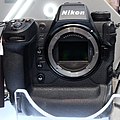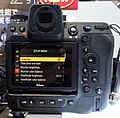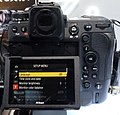Top Qs
Timeline
Chat
Perspective
Nikon Z9
2021 full-frame mirrorless camera From Wikipedia, the free encyclopedia
Remove ads
The Nikon Z9 is a flagship full-frame mirrorless camera produced by Nikon. The camera was announced on October 28, 2021. It is the eighth Z-mount camera body and the sixth full-frame Z-mount body.

When launched, Nikon used the marketing slogan: “Unstoppable.”[4]
Remove ads
Image sensor and processor
The Z9 has the same 45.7 MP resolution as the Z7 and Z7II cameras, but uses a much faster stacked CMOS sensor which improves autofocus and continuous shooting performance.[5][6]
The Z9 introduced the EXPEED 7 image processor, which provides an improvement of 10 times over the image processing speed of the EXPEED 6 predecessor, which was used in the previous Nikon full-frame Z6II and Z7II cameras. The continuous shooting capabilities of the Z9 significantly exceed those of Nikon's previous Nikon D6 while providing more than double the resolution. The Z9 is the first Nikon Z camera to support 8K video, which can be recorded internally at 60 fps in 12-bit N-RAW.
The Z9 is the first flagship full-frame camera without a mechanical shutter.[7]
Remove ads
Lenses
The Z9 uses the Nikon Z-mount, developed by Nikon for its mirrorless digital cameras.[8]
Nikon F-mount lenses can be used, with various degrees of compatibility, via the Nikon FTZ (F-to-Z) and FTZ II mount adapters.[9]
Features
- "Synchro VR" where both in-body and in-lens image stabilization can stabilize the same axes.
- Advanced autofocus, with subject detection of people, faces, animals, birds, vehicles, and airplanes.
- Burst lengths of over 1000 shots (previous Nikon cameras were limited to at most 200 shots per burst).
- Internal 10-bit video recording in H.264, H.265 and ProRes 422 HQ (also supports HLG and Nikon N-Log).
- Internal 12-bit raw video recording using ProRes RAW HQ (up to 4.1K at 60 fps) and Nikon N-RAW (up to 8.3K at 60 fps) using intoPIX TicoRAW.[10] .
- Video recording length limit extended from 30 minutes to 2 hours and 5 minutes.
- Dedicated "sensor shield" to protect the sensor from dust and dirt when the camera is off or the lens is taken off.
- VR lock to reduce sensor shock during standby.
- 10-pin remote and flash sync connectors.
- Built-in GPS, GLONASS and QZSS receiver for geotagging.
- Allows switching between linear and non-linear focus throw in manual focus with some lenses.[11]
- "Dual-Stream Technology" providing separate paths for capturing images and updating the viewfinder, which eliminates viewfinder blackout and reduces viewfinder lag.
Z9 generation
The Z9 was the first of the so-called "Z9 generation" of Nikon cameras, including the Z8, Zf, Z6III, Z50II, and Z5II. They all use the Expeed 7 image processor, autofocusing system, a revamped menu structure, button customization options, and video-related features.[12]
Use in outer space
In January of 2024, Nikon revealed that NASA launched 13 unmodified Nikon Z9 cameras to the International Space Station (ISS) via the 20th Northrop Grumman commercial resupply services mission.[13][14] The new Nikon Z9 replaced the aging high-end Nikon D5 and D6 DSLRs on board the ISS.
On February 29, 2024, NASA revealed a signed agreement between them and Nikon to develop the Handheld Universal Lunar Camera (HULC) as the first handheld camera to be used on the Moon, for use beginning with the Artemis III mission. The resulting design consists of a modified Z9 camera with thermal shielding, custom grip with modified buttons, and modified electrical components to minimize issues caused by solar radiation.[15][16]
Nikon Corporation and NASA share a long history together with Nikon being the camera brand that continuously supplies the agency with modified cameras since the 1970s.[17]
Remove ads
Gallery
- Sensor, with sensor shield not engaged
- Top controls and top screen
- Main display in a tilted orientation
Awards
The Z9 has won numerous awards:
- Camera Grand Prix 2022 Camera of the Year[18]
- Camera Grand Prix 2022 Readers Award.[18]
- Best of the Best: 2022 Red Dot Product Design Award[19]
- Camera of the Year: EISA Awards 2022-2023[20]
- DPReview Awards 2021 Product of the Year[21]
- DPReview Gold Award & Highest Ever Score[22]
- 2022 TIPA World Awards: Best Full-Frame Professional Camera[23]
- RedDot Product Design Awards 2022: Best of the Best[24]
- iF Design Award 2022[25]
Remove ads
Update history
Summarize
Perspective
The Z9 received several major firmware updates since the initial release. Notable features added by firmware updates include: Firmware 2.0 adding internal N-RAW video recording, "pre-release capture" and 120 Hz operation of the electronic viewfinder. Firmware 3.0 added video flicker reduction and digital zoom for 4K video, as well as a 19 MP 60 fps continuous release photo mode and general autofocus improvements. Firmware 4.0 added "auto capture", which can automatically trigger shutter release upon motion, subject or distance detection, and improved autofocus as well as video functions. Firmware 5.0 added several functions to the "auto capture" feature for more automated workflows as well as improvements to flicker reduction, several minor features and usability improvements.
Remove ads
References
External links
Wikiwand - on
Seamless Wikipedia browsing. On steroids.
Remove ads






